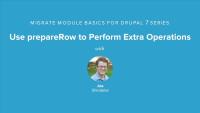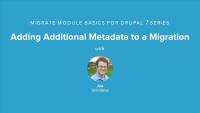The Drush executable can be configured through the use of YAML configuration files and environment variables. This configuration can help cut down on typing lengthy frequently-used commands. You can tell Drush to look for command files in project-specific locations. Configuration can also set the value(s) of a specific command's options, instead of having to type them at the command line every time.
In this tutorial we'll:
- Explore different Drush configuration options
- Learn how to configure Drush for your project
By the end of this tutorial, you'll know how to provide project specific, and global, configuration that helps customize Drush and improve your own efficiency.
Creating a custom Drush command requires creating a PHP class that Drush can find with methods that have PHP attributes that provide metadata about each custom command. You'll use an autowire trait to inject any services into it. You'll also optionally modify the project's composer.json to tell Drush what versions of Drush the command is compatible with.
Custom Drush commands are a great way to expose your custom module's features to help automate these tasks and allow users to perform them as background processes. They can also provide a more efficient way to execute PHP code that takes a long time and is prone to timing out when run via the web server.
Depending on your use-case it can also be more efficient to create a custom Drush command to execute your logic instead of coding a complete UI. For example, if all the command needs to do is generate a CSV list it might take less effort to write a Drush command and pipe the output to a file than to create a UI that generates a file and prompts the user to download it.
In this tutorial we'll:
- Declare a new custom Drush command inside a custom module
- Make our custom Drush command output a list of all the blocked users on the site
- Verify our new command is working
By the end of this tutorial you should understand how to create a custom Drush command that returns a list of blocked users.
Developers can implement the Drush Command API to write their own custom Drush commands. This allows you to include Drush commands with your modules to allow the module's features to be used via the CLI. You can also create project-specific Drush commands that help with the development, deployment, and maintenance of your particular application.
We've written Drush commands to help generate reports, make it easier for new team members to get up and running, compile custom theme assets, and more. Any time we need to write PHP code that interacts with our Drupal site where we're worried the code might time out because it takes too long to execute we'll reach for Drush. Custom Drush commands are also useful to combine background processes that can be executed on cron, such as nightly imports, data synchronization, bulk database manipulation, custom queues processing, and so much more.
In this tutorial we'll:
- Learn about different types of custom Drush commands
- Review the anatomy of a Drush command
- See how the Drush bootstrap process relates to commands
By the end of this tutorial, you'll be able to identify the parts of a custom Drush command and start writing your own.
In addition to using one of the existing generators, developers can write their own Drush generator commands. This can help speed up repetitive tasks and reduce the use of boilerplate code that is prone to human error.
Generators are provided through Drush's integration with the Drupal Code Generator project. Writing new generators isn't specific to Drush, though if you're creating generators for Drupal it is definitely easiest with Drush as a wrapper.
Similar to Drush commands, generators can be supplied by a Drupal module or declared globally. If you have a feature-specific functionality, it's best to ship your custom generator within the custom module. Otherwise, a global generator can be declared and used.
In this tutorial we'll:
- Explain the anatomy of a Drush generator
- Write a custom Drush generator for handling a site's development.services.yml file, and use it in a project
By the end of this tutorial you should understand how to create, or customize, a Drush code generator and use it in your project.
One of the problems that Drush solves for developers is the automation and optimization of routine tasks. Drush commands attempt to speed up workflows and tasks that developers and site maintainers would otherwise have to do manually through the UI, or run one-by-one via the command line. One of those tasks is the process of deploying changes to a Drupal application from one environment to another.
The typical Drupal deployment process consists of repeatable steps such as importing configuration changes, applying database updates, and clearing the cache. Drush comes with the handy drush deploy command that allows you to automate the execution of all of these tasks post code deployment.
In this tutorial we'll:
- Learn about the
drush deploycommand - Discuss when you would use the
deploycommand
By the end of this tutorial you'll know how to use the drush deploy command in conjunction with other useful deployment-related commands to help automate the task of deploying changes to a Drupal site's configuration and code.
Code generators are great productivity boosters that allow generating scaffolds for common development tasks in Drupal. One of the most common use cases for generators is scaffolding the code required for a custom entity type. Custom entities require many files and complicated annotations in order to function properly. There is a lot of boilerplate code that is more-or-less the same for every entity type. Creating all the files is repetitive, time-consuming, and prone to human error. Generators can help automate this task and make creating your own custom entity types quicker.
In this tutorial we'll:
- Learn how to generate the code for a custom entity with Drush
- Learn about the options that generators provide for custom entities
By the end of this tutorial you should know how to generate custom entities with Drush.
Some Drush commands return a lot of information -- lists of modules, generators, and status reports, for example. It might be hard to find a property you need in the small command window output. Luckily, the output of Drush commands can be piped to other commands, used as a source for imports, settings for CI, and other DevOps tasks.
In order to accommodate all these different use cases, Drush comes with a formatting system that allows you to format and filter output to meet your needs. This system allows to you specify what fields you want returned when the output contains more than one field. It also allows Drush command output to be formatted as JSON, XML, raw PHP, a table, and more.
In this tutorial we'll:
- Learn how to specify the output format -- and what formats are available
- Limit the fields that are returned in a report
- Learn to filter the output to only the data we're interested in
By the end of this tutorial you'll know how to format a Drush command's output to fit your needs.
If you want to change the way an existing Drush command works, you use hooks. Hooks are useful for altering command parameters, options, attributes data, and adding custom logic during particular stages of the command execution process. Drush hooks are conceptually similar to Drupal hooks.
Hooks are methods on a Drush command class with an attribute indicating what hook is being implemented, and thus when the code should be invoked. The code in the methods is executed during specific stages of the command cycle. Developers can use core hooks -- predefined methods that come with Drush core -- or declare a custom hook that other commands can use.
In this tutorial we'll:
- Explore the different core Drush hooks
- Learn which hooks are called at what stage of the command cycle
- View example hook attributes and method implementations
By the end of this tutorial you'll know what types of core hooks are available to you and when they are called.
Adding logging and error handling are an important part of authoring Drush commands. Logs allow developers to get timely feedback from a command and inform users about potential alterations and flags, events to monitor, and the progress of long-running commands. Correct error handling allows for clean exits, meaningful error descriptions, and provides a path forward for developers to fix the errors and accomplish their goals.
In this tutorial we'll:
- Explore the different types of logging messages Drush commands can output
- Learn how to handle errors from within a Drush command
By the end of this tutorial you'll know what types of log messages you can use; how to log success messages, errors, or debug statements from a custom Drush command; and how to handle errors and exceptions.
When the logic of a command depends on user input, it's useful to set up an interactive questionnaire inside the command code. This allows you to provide the user with more context about the input they're providing, and ensure that you collect all the necessary values. This is especially useful when the command uses a pre-defined list of options and the values require memorization. An example of this is the drush cache-clear command that comes with Drush core. It requires an argument indicating which cache to clear, which you can specify at the command line; however, if you invoke the command with no arguments it will present you with a list of cache bins to choose from and a UI for selecting one.
Drush 9+ can access the Input/Output (I/O) object via the $this->io() method. This object -- an instance of \Drush\Style\DrushStyle -- holds information about user-provided input, and utilities for manipulating that input. To ask a user a question, use an io() object in the command callback method. It can take over the execution flow of the command as needed to stop and gather additional input. The I/O system has various methods for asking confirmation or choice questions such as confirm() and select().
In addition to prompting for input, the I/O object can be used to provide other styling to the command, like progress bars.
In this tutorial we'll:
- Learn how to prompt the user for additional input
- Process the user's answer as part of the command execution flow
By the end of this tutorial you should understand how to prompt a user for additional input for a custom Drush command.
While Drush empowers all Drupal users with its commands, it's even more powerful when used in combination with scripting solutions such as Composer and Bash. Scripts can be used to power post-deployment tasks like importing new configuration or clearing the cache, as part of CI processes to sync a database from one environment to another, to run background processes on the server such as imports and migrations, search indexing, running cron, and much more. If you want to write Bash (or any other scripts) that interact with a Drupal site, then Drush is the tool for you.
In this tutorial we'll:
- Learn how to use Drush commands within Composer and Bash scripts
- Learn how to chain multiple Drush commands together in a script
By the end of this tutorial you'll know how to use Drush as part of a script that automates common or tedious tasks.
When you manage many Drupal websites, you may perform repetitive tasks that are common across all of your sites. In our experience, this usually relates to having a personal preference for how certain tasks are accomplished. For example, maybe you like to make backups of the database and files in a specific way before testing upgrades, or you have a set of scripts for running scans of core web vitals. Although these tasks can be bundled into a custom module, it could be useful to create a site-wide Drush command instead. Site-wide commands can be installed with Composer, managed in a separate Git repository, and act as a project dependency. This way they are easy to maintain through a separate upstream. Changes to this code will be reflected on all the sites where it's used.
In this tutorial we'll:
- Declare a custom site-wide Drush command
- Demonstrate how to use Composer to manage a package that contains a Drush command
By the end of this tutorial you'll be able to create a site-wide Drush command and manage the code with Git and Composer.
The Migrate module itself contains some excellent examples of data migrations implementing the various APIs provided by the module and serves as the canonical documentation for how to write a migration. In this lesson we'll take a look at the beer and wine import examples provided with the migrate module as a way to familiarize ourselves with the concepts discussed earlier and to be able to see the code that makes up a basic migration before attempting to write our own. In practice these examples serve as a great starting point and can often times be copy/pasted and adjusted for your own needs.
Additional resources
Before we can write our own custom migration we need to construct the site that we're going to import data into and of course we need some source data to import. In this lesson we'll obtain some source data to work with and configure our Drupal site by installing a couple contributed modules, and creating the content types and fields necessary for our information architecture. During this process we'll also be taking a look at the baseball player and team data that we'll be importing and familiarizing ourselves a bit more with the tables and columns in our source database.
Note: The Lahman database structure has changed since this video was recorded, and the latest files provided by Lahman don't match what is used in the video. When following along with these examples you'll either need to use the 2012 source data, or make a few adjustments to field/table names throughout the source code as you follow along so that they match the current structure of the Lahman data.
Additional resources
Running your own migration requires a bit of setup and boilerplate code, Drupal needs to know where to find the source data, and the Migrate module needs to be provided with some basic information about our custom code. In this lesson we'll look at setting up Drupal to be able to connect to multiple databases, and then create the skeleton of a simple module which will house our custom migration code and an implementation of hook_migrate_api(). Finally we'll create a base class from which we can begin writing our own custom migrations, and talk about why this is a good way to start organizing our migration.
In this lesson we're going to write our first custom data migration and start importing some of the player data in to Drupal. The primary concepts covered in this lesson are the creation of a migration class following the pattern necessary for Migrate module to be able to discover our code and then dealing with defining source and destination objects so that the Migrate module will know where to read data from and where to write data to. Finally we'll add a simple single field mapping where we map the player's name to the node.title field allowing us to run the migration for the first time and import some real data.
Additional resources
In this lesson we'll continue to add field mappings to the basic migration class created in the previous lesson. We'll see how to add more information about the available source fields. We'll map more of the player source data fields to their equivalent destination fields and learn about some of the many ways that fields can be mapped. Finally we'll also cover mapping sub-fields which allows us to import data for things like the text format of a node's body field or the alt column in an image field. Information that's contained within a meta field.
Additional resources
In this lesson we're going to finish mapping the fields for the player migration and learn about how to deal with source data that requires some additional massaging before being saved to the destination. We'll learn about the use of field mapping callback functions and the migration's prepareRow method as possible spots to perform additional logic during a migration. Then we'll use these techniques to combine our player first and last name fields together for the node title field, deal with our birth and death date fields by concatenating the three source columns together into a single date string, and finally add some additional information to the notes field during import that will allow us to track imported records in the future.
Note: This lesson was recorded using the 7.x-2.6 version of the date module, however the 7.x-2.7 version is now out which contains some changes to the module's integration with the migrate module. The biggest change being that the date_migrate module is no longer required and has been deprecated. You can read more about the changes here: https://drupal.org/node/2034231
Additional resources
Although not required when writing your own migration, the Migrate module provides ways for us to decorate our migrations with additional information making it easier to keep track of who is working on what, what needs to get done, and related issues. We've already seen some of this in previous lessons with with the Do Not Migrate option for fields and ability to provide field mapping descriptions. In this lesson we'll take a look at how we can make use of the additional tools to do things like; Show the name, contact info, and roles of individuals working on the migration, pose questions to other team members via the migration UI, and link individual field mappings to related tickets in our bug tracking software. Making it easier for team members who don't want to be involved with the code to help move our migration along.
Additional resources
In this lesson we're going to take a look at creating relationships between two Drupal nodes during a migration. In our case we've got player and team nodes, and each player node has an entity reference to a team node which we need to populate during our migration. In order for this to work we need to ensure that the team node has already been created so that we know the unique node.nid to use in the entity reference field for the player.
To accomplish this we're going to write a migration for team data and ensure that it is run prior to our player migration being run. Then we're going to make use of the mapping between source and destination rows that the Migrate module is tracking for teams so that during a player migration we can lookup the corresponding team node's nid and make use of it.







